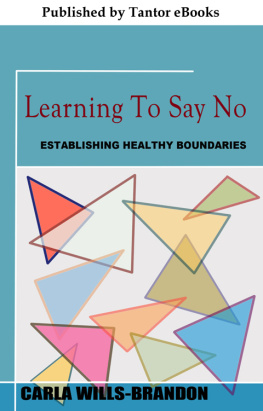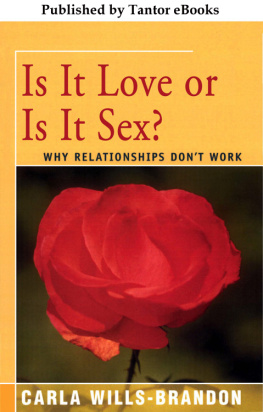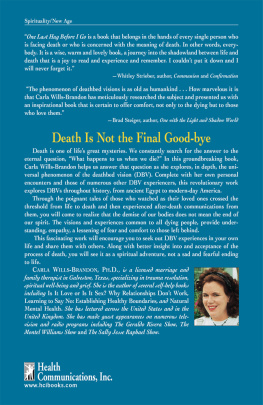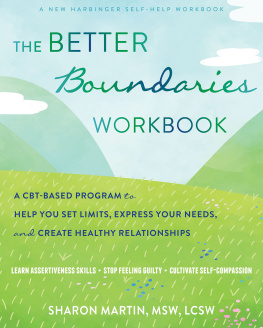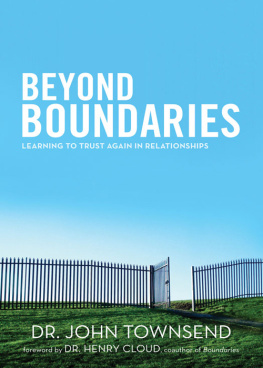Carla Willis-Brandon - Learning to Say No: Establishing Healthy Boundaries
Here you can read online Carla Willis-Brandon - Learning to Say No: Establishing Healthy Boundaries full text of the book (entire story) in english for free. Download pdf and epub, get meaning, cover and reviews about this ebook. year: 2012, publisher: Tantor eBooks, genre: Home and family. Description of the work, (preface) as well as reviews are available. Best literature library LitArk.com created for fans of good reading and offers a wide selection of genres:
Romance novel
Science fiction
Adventure
Detective
Science
History
Home and family
Prose
Art
Politics
Computer
Non-fiction
Religion
Business
Children
Humor
Choose a favorite category and find really read worthwhile books. Enjoy immersion in the world of imagination, feel the emotions of the characters or learn something new for yourself, make an fascinating discovery.
- Book:Learning to Say No: Establishing Healthy Boundaries
- Author:
- Publisher:Tantor eBooks
- Genre:
- Year:2012
- Rating:5 / 5
- Favourites:Add to favourites
- Your mark:
- 100
- 1
- 2
- 3
- 4
- 5
Learning to Say No: Establishing Healthy Boundaries: summary, description and annotation
We offer to read an annotation, description, summary or preface (depends on what the author of the book "Learning to Say No: Establishing Healthy Boundaries" wrote himself). If you haven't found the necessary information about the book — write in the comments, we will try to find it.
Do you have difficulty saying No! to the demands of others? If so, this book is for you. Learn how to set boundaries and limits with your partner, children, family, friends and even the boss. Ms. Wills-Brandon will show you how to care for yourself in your relationships. This book was a Publishers Weekly Best Seller.
Learning to Say No: Establishing Healthy Boundaries — read online for free the complete book (whole text) full work
Below is the text of the book, divided by pages. System saving the place of the last page read, allows you to conveniently read the book "Learning to Say No: Establishing Healthy Boundaries" online for free, without having to search again every time where you left off. Put a bookmark, and you can go to the page where you finished reading at any time.
Font size:
Interval:
Bookmark:
LEARNING |
Establishing Healthy Boundaries
Carla Wills-Brandon
LEARNING TO SAY NO: ESTABLISHING HEALTHY BOUNDARIES
Copyright 1990, 2000 by Carla Wills-Brandon
This electronic format is published by Tantor eBooks,
a division of Tantor Media, Inc, and was produced in the year 2012, All rights reserved.
DEDICATION |
This book is dedicated to all of the Carlas who live within me.
ACKNOWLEDGMENTS |
Another book is born and its completion has been made possible by many more than meet the eye.
Michael, my mate in recovery, was the unfortunate guinea pig who first experienced many of the boundary exercises presented in this book. I love and appreciate his willingness to explore one more area of growth with me.
My son Aaron also contributed greatly to this book, even though he was only three years of age at the time it was evolving. He taught me about the word no and demonstrated how it could be used in a variety of situations. His ability to say no taught me that to set boundaries is a basic human right that most of us were not allowed.
Rita Baker once again did a bang-up job typing the overwhelming number of hand-written pages which have evolved into the text of this book. I know reading through my scrawling isn't easy and her talents are greatly appreciated.
Marie Stilkind, my editor, is a dear friend who gave this work the polish that it needed for success. I will always value her creativity and her friendship.
I would also like to thank the entire Health Communications and U.S. Journal family, along with the crowd at the Diane Glynn agency for the work they have done in promoting me as an author. I appreciate the risks that have been taken on my behalf.
Finally, I need to express my appreciation to all of the family, friends, clients and peers who have not only provided me with many situations for setting boundaries but who have also been willing to risk and set boundaries with me. Thanks to all who have given me an opportunity to learn how to take care of myself in healthy ways, as opposed to depending on those dysfunctional survival skills I learned during childhood.
CONTENTS |
INTRODUCTION |
Hello, my name is Carla, and I am recovering from the first half of my life. The recovery process has been a rewarding, and yet at the same time, curious experience. Before entering my recovery I had spent thousands of dollars and many hours in traditional psychotherapy trying to figure out what was wrong with me. I had always felt as if I had a screw loose somewhere in my being and was constantly looking for that one drug, therapist, classroom experience, workshop, encounter group or guru that could repair me. I felt so damaged and hopeless, wishing only to feel a part of the human race.
I wanted specific answers to my problem or, better yet, a "Big Fix" that would make me feel complete. Grasping after anything, I was looking for some hint to my dilemma such as, "If you do this the result will be... and poof... you will find your true self and live happily ever after." It sounded easy enough, but it sure felt beyond my reach. I felt as if I had been set aside from the rest of humankind to be miserable for life.
Therapy started at age 19 with traditional psychotherapy. I was concerned about my drinking because it reminded minded me of my mother's. I was assured my drinking wasn't a problem and was promptly subjected to hypnosis. Thinking maybe my subconscious mind would give me some answers, I was a very willing subject. But my cure wasn't there, most likely because I was a full-blown alcoholic and under the influence at times during therapy sessions. This probably attributed to the ease to which I was hypnotized.
When traditional psychotherapy didn't appear to work, it was suggested I try Valium. I said no thank you because a number of women in my family of origin had been addicted to the drug. It was then suggested I try Ativan. I had never heard of Ativan and thought, why not? Maybe this was the magic potion I needed. The tranquilizer Ativan proved to be Valium's sister and very addictive. Ativan mixed with booze depressed me even more, and I was disappointed that my fantasy about this little pill was truly a myth.
Eventually, another helping professional suggested I try the latest thing on the market for my "blues." This little bit of magic, he stated, was called an antidepressant. He also assured me that these pretty blue pills were not addictive. My blue pills made me feel "null and void," and I never felt like I was really in my body. I was positive that antidepressants were not my cure but decided to mix them with the Ativan and alcohol anyway. By the way, my body had the most difficult time detoxing off the antidepressants while in treatment for chemical dependency.
One day, in a fit of rage, I cried out, "Why am I so screwed up?", hoping God or somebody would answer me with a burning bush, lightning bolt, postcard or some type of sign which would place me squarely on the golden road toward inner peace. Well, I never did see a burning bush or get a postcard from God, but I did eventually discover I was an alcoholic, drug addict, food addict, co-dependent, love addict with a set of lifeskills that were useless. I also discovered that, along with all of my active addictions, my concepts and fantasies about life all came from my family of origin and the television set, neither of which was very healthy.
Slowly, one by one, I began letting go of the chemical addictions. After I achieved sobriety from pills and booze, my brain started to defrost. I noticed the sky was blue, my eyes were green and that I had a strong desire to learn about life. Next I found recovery for my eating disorder. After being out of touch with my body for so many years, I began to really feel in my body and discovered my physical appearance was not so bad after all. As time went on, I learned how to love my height of six feet and my size 11 shoe size.
Eventually, I said good-bye to cigarettes. I had a funeral for my last pack of cigarettes and also for my ashtrays, lighters and matches. Though I knew it was time to let go of this addiction, I felt some sadness as I flushed the last five cigarettes down the toilet. Nicotine had enabled me to suppress my feelings of anger and fear during a time when I was not capable of learning from them. As I progressed in my own process of self-discovery, I learned I needed to experience anger and fear for my own growth.
Two years into my own recovery I felt overwhelmed. I didn't have any more chemicals to hide behind. I felt alone and vulnerable without protection. Memories from childhood began to make their presence known in my dreams, reactions to others, behavior at work and with family. Vivid memories of emotional, physical and sexual abuse began to surface and haunt me like clips from an old horror movie. At times I really thought I was going crazy and questioned why I had given up all of those mood-altering chemicals.
I began to respond to scenes on television. My body would freeze up if a sexually abusive scene was displayed on television, or I would burst out crying if the scene involved loud fighting. At the time, I had no idea that what I was seeing and hearing on television had happened to me and that my body was remembering, even though my mind had forgotten.
With these overwhelming feelings, the next phase of my recovery from the first half of my life began. I started exploring how I had grown up, what my family of origin was like and how I had been abused.
I discovered, with a great deal of patient help, that I had been very abused in a number of ways. So I beat on pillows, threw old mayonnaise jars and raged at those who abused me. I even yelled at God and the universe for the pain I had experienced as a child. I wrote letters to those who had abandoned me and confronted others who had hurt my body, heart and soul. I grieved with several of the inner children who were hiding within me, and I learned how to nurture myself and them. I grieved deeply for the myths I had about my childhood as I let go of them one by one.
Font size:
Interval:
Bookmark:
Similar books «Learning to Say No: Establishing Healthy Boundaries»
Look at similar books to Learning to Say No: Establishing Healthy Boundaries. We have selected literature similar in name and meaning in the hope of providing readers with more options to find new, interesting, not yet read works.
Discussion, reviews of the book Learning to Say No: Establishing Healthy Boundaries and just readers' own opinions. Leave your comments, write what you think about the work, its meaning or the main characters. Specify what exactly you liked and what you didn't like, and why you think so.

